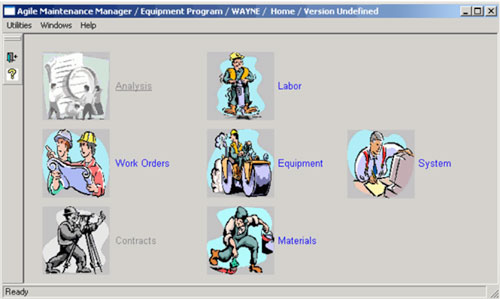Best Practices for Road Weather Management
Montana DOT Equipment Vehicle Management System
The Montana Department of Transportation (MDT) developed an Equipment Vehicle Management System (EVMS) to provide a comprehensive solution for managing, monitoring, and controlling fleet operations for both the State Motor Pool and the Equipment program. In developing the system several essential principles were considered, including: preserving the fleet through timely servicing; conducting preventive maintenance and repairs; recording equipment rental rates and financial information; identifying impending fleet repairs to reduce downtime; maintaining an equipment replacement log that identifies equipment age and maximum lifetime; ensuring efficient and economical use of the fleet and manpower; and purchasing vehicles and equipment that are multifunctional and that will support maintenance, engineering, construction and other user requirements. EVMS is utilized by 16 mechanic shops statewide.
System Components: The EVMS is comprised of four modules: Labor Equipment; Materials; and System, as software application window illustrated in Figure MT-1.
The Labor Module performs all functions related to the assignment of personnel. Capabilities include transferring employees across administrative units, setting up crews, defining a calendar from which to create time cards, and the creation of administrative work orders.
The Equipment Module handles any and all equipment activity. The functionality includes purchasing, repairing, fueling, servicing, and sale/salvage for all equipment.
The Materials Module provides a system for the management of material resources. These include capabilities for tracking material stockpiles, purchasing new supplies, managing the warehouse inventories, and requesting materials from other administrative units.
The System Module controls settings of the software and maintains settings for system interfaces (like fuel transactions, for example).
System Operations: MDT mechanics maintain equipment through preventative measures and necessary repairs. When using the EVMS to catalog work performed, the mechanic selects the Equipment Module, and specifies the particular issue and notes an in-house repair. To establish a repair order, the mechanic selects the unit/vehicle number and proceeds to process the repair by selecting the work activity, entering labor hours per activity, listing parts used, and checking warranties. Down time is also recorded. Once the repair order is completed the mechanic signs-off and it is ready for the approval of the shop superintendent.
Transportation Outcome(s): The EVMS system manages all aspects of maintaining and preserving the State Motor Pool fleet and Equipment. The benefits of utilizing EVMS are digital records of inventory, scheduling and tracking repair orders, tracking labor and materials cost, “real time” report utilization, tracking of warranties, recording fuel and mileage history, and online scheduling of statewide motor pool reservations. By providing these types of data, the system can maximize equipment lifetime, decrease maintenance and repair costs, and increase vehicle utilization for maintaining and constructing state roads.
Implementation Issues: The EVMS system version 3.4 was implemented in March 2004. Since its implementation the application has undergone minor enhancements. MDT is currently still using client/server architecture for the system. A project is now underway to upgrade the existing EVMS to a web-based system, which will create one location and one access point for the entire program.
Contact(s):
- Michele Cheeseman, Computer Support Specialist, 406-444-9274.
- Jeff Gleason, Equipment Bureau Chief, 406-444-6151.
- Walt Kerttula, Supervisor and Financial Specialist, 406-444-6319.
Reference(s):
Keywords: Fleet Management Systems, Fleet Software, DOT Asset Management.
previous | next